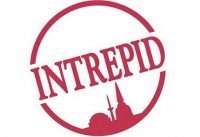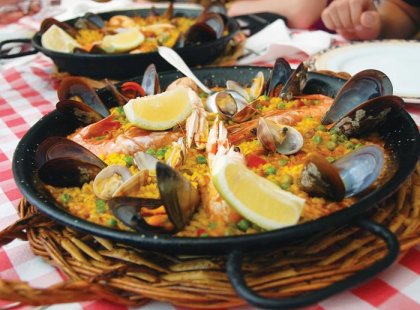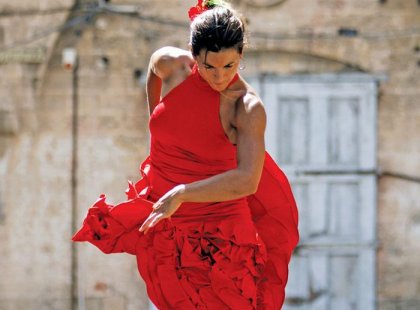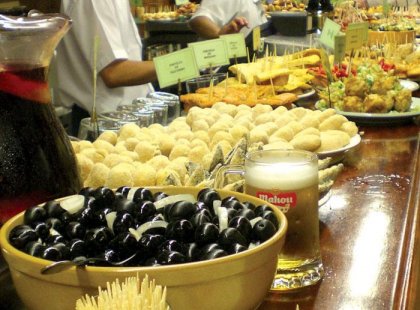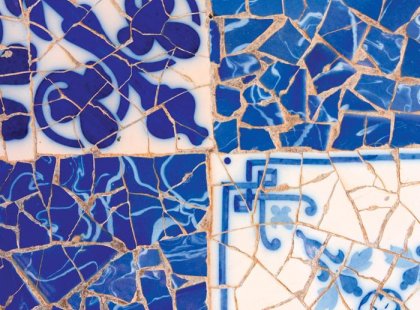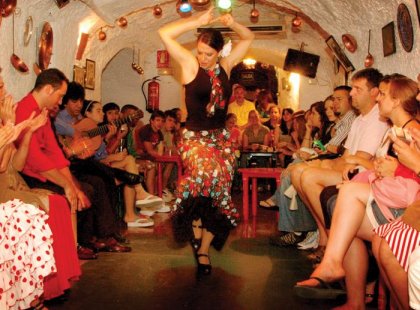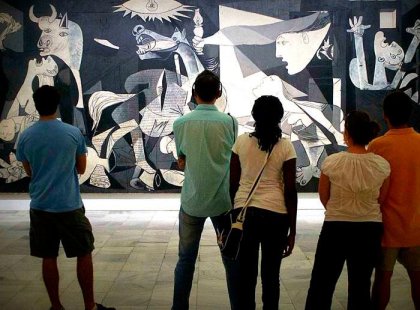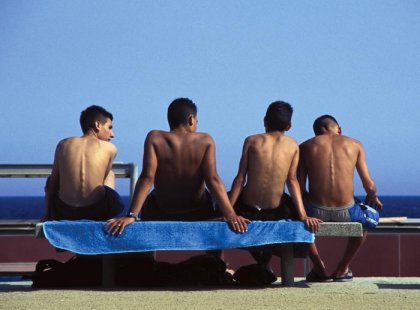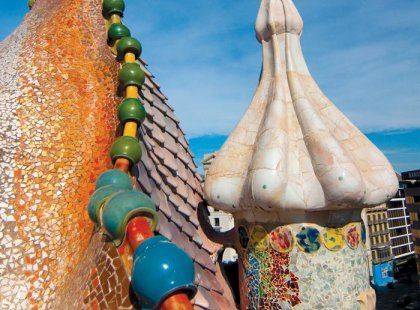Classic Spain
22 days
from Madrid to Madrid
From
$ 5225
Duration22 days
Visit Classic Spain on a tour via Madrid, Barcelona and San Sebastian. Visit Spain's star attractions on a classic tour through the country. Starting in Madrid, let your imagination unfold on a journey through this beautiful country oozing with charm, and visit the people and cities that reflect Spain's fascinating history and culture. Tour through Cordoba, Valencia, Barcelona and San Sebastian as you experience a fiery flamenco performance, follow your tastebuds to a tapas bar, admire unique architectural triumphs, worship the sun at the beach and sip some of the best red wine in the world - this adventure through Classic Spain is as colourful and diverse as the land itself.
-
Duration: 22 daysService level: Standard
-
Starts in: MadridPhysical Grading: Light
-
Ends in: MadridAges: 15+
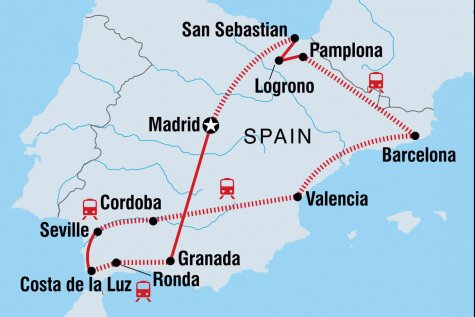
Itinerary
Day 1: Madrid
Start place: Madrid
Welcome to Madrid, Spain. The sassy central capital is known for its elegant boulevards and expansive, manicured parks, but it also pulsates with energy, and is without doubt a vibrant city. Your adventure begins with a welcome meeting at either 6pm or 7pm, depending on common area availability. Please double check with reception to confirm the time and place. If you're going to be late, please inform the hotel reception. We'll be collecting your insurance, passport details and next of kin information at this meeting, so please have these on hand. If you can't arrange a flight that will have you arrive at the hotel by early evening, you may wish to arrive early. We'll be happy to book additional accommodation for you (subject to availability). As there's limited time for sightseeing in Madrid, we recommend arriving a few days early to explore. Perhaps while away the hours along the Paseo del Arte, or Art Walk, for an expansive history of Western art. Start with the Museo del Prado, then discover modern Spanish masters, including Picasso and Dali, in the Museo Reina Sofia. Finish at the Museo Thyssen-Bornemisza, which displays eight centuries of European painting. After the welcome meeting, and optional dinner, perhaps get into the mind of a Madrileño with some tapas and Rioja, or head to the Gran Via hotspots to dance the night away.
Day 2: Granada
Take a bus to Granada today (approximately 5 hours). Located at the foot of the Sierra Nevada Mountains, Granada is packed with Moorish architecture, great tapas bars and natural beauty. Take a walk around the old Arab quarter of the Albaicin, a labyrinth of crooked alleys, fountains, plazas and whitewashed houses, or the 'Alcaiceria' (old silk market area) and observe the craftworks on sale that include ceramics, marquetry and leather goods. If you're feeling energetic, climb the steep streets up to the Mirador de San Nicolas for sunset views over the famous Alhambra. If you have time, perhaps check out the historic Renaissance Catedral and Capilla Real. Granada is the kind of city to leave your guidebook behind and trust your intuition.
Day 3: Granada
Today make a visit to Granada's impressive Alhambra Palace. An entrance ticket is included in the trip and grants you the visit of Nasrid Palace and the Gardens. The Alhambra was first built by the Moors as a fortress during the Muslim rule of Spain. A walk through the compound's luxurious rooms and gardens gives you an idea of the decadent lifestyle of the Moorish kings. The Alhambra is made up of three parts: the Alcazaba, the 11th-century Muslim wing which features spectacular views from its towers; the Palacio Nazaries, the centre of the complex; and Generalife, the summer palace of the sultans. This evening, unearth the restaurants in the tangled streets of the Albaicin and dine with the best views of the Alhambra.
Meals: B
Day 4: Ronda
Leave Granada behind and travel by train to the Andalucian hills and the white-washed town of Ronda. A landscape of green forests and white limestone mountains, Ronda is the birthplace of bullfighting in Spain and was a favourite of Hemmingway and Orson Welles. The highlight of the town is the spectacular Puente Nuevo (New Bridge), one of the most photographed structures in the country. Built in 1751, it bridges the 100-metre deep gorge that splits the town in two. You can walk across it, stopping to peer over a vertiginous drop from one of its balconies. Check out the old Moorish town on one side, home to many historic buildings including the House of the Moorish King, and the newer El Mercadillo on the other side. East of the town are well-preserved Arab Baths and, of course, the famous Plaza de Toros. In the evening, find a spot from which you could enjoy a scenic sunset; this won’t be a problem in Ronda.
Meals: B
Day 5: Ronda
Take a walk through Los Molinos, the beautiful valley surrounding Ronda. You can head down into El Tajo, the gorge that separates the old and new town, and get a view of the bridge and town from below. The rest of the day is free to explore town. The Plaza de Toros is one of hte oldest bullfighting rings in the country, and adjoining the bullring is the Bullfighting Museum, which displays relics of Ronda's bullfighting history. The gardens behind offer panoramic views over the surrounding mountains, which have a long history of sheltering bandits and smugglers. Visit the Museum of Bandits for an entertaining insight into their history, or check out the prize-winning wineries and beautiful national parks that surround the town.
Meals: B
Day 6: Costa de la Luz
Today you'll travel south-west to the Costa de la Luz (Coast of Light) by train. This western Andalusian coast faces the Mediterranean and North Africa and your base for the next two nights is Tarifa, a laid-back beach town endowed with spectacular rocky scenery, a sea fortress, a lighthouse and plenty of character. The afternoon is free to relax. Perhaps catch a bus to the 10 kilometre-long sands of Playa de Los Lances – a haven for kite surfers – or hole up at a beach bar on Playa de Valdevaqueros. One of the best ways to appreciate the area is simply to wander, along the promenade under the old castle, past restaurants brimming with fresh seafood, and appreciate this rare, underdeveloped stretch of Spanish coastline. The surfers lend the old town a laid-back, international vibe, along with hints North Africa, which lies just across the water. In the evening, why not grab some dinner in town and join in Tarifa's vibrant nightlife.
Meals: B
Day 7: Costa de la Luz
Today there are plenty of optional activities to choose from. Perhaps head out on a whale and dolphin watching expedition on the Iberian Peninsula. At this unique place, where the Mediterranean Sea meets the Atlantic Ocean and where Europe meets Africa, you'll have a chance to see seven different species of whales and dolphins. Alternatively, take a day trip to Northern Africa and the town of Tangier in Morocco, just 45 minutes away by ferry. Once a hotspot for artists, secret agents and millionaires, Tangier has been going through something of a renaissance of late. The city's medina and kasbah are well worth exploring, as are the cafes and patisseries around the Place de la France in the Ville Nouvelle. You can unwind and take in the charms of the city on the recently reconstructed beach promenad or one interesting option is a day tour across the border to the British territory of Gibraltar, home to the famous Rock of Gibraltar. Here you can take a cable car up to the rock’s peak, explore the caves, visit a Moorish castle and wander the main street, discovering the interesting blend of old British life and Spanish flavours.
Day 8: Seville
Travel to the vibrant city of Seville. If the legends are to be believed, Seville was founded by Hercules and its origins are linked with the Tartessian civilisation. To the Romans it was Hispalis, to the Moors Isbiliya. After the Christian Teconquista, it became known as the portal to the 'New World', and is today the capital of Andalucia and the largest city in southern Spain. Known for its important monuments and fascinating history, Seville is universally famous for being a joyous town. Sevillians are well known for their wit and sparkle, and the city itself is striking for its vitality and flamboyance – the city of Carmen, Don Juan and Figaro. Seville is also famous for its oranges, tapas and flamenco, all three of which are ingrained in the fabric of the city and its proud people. As the rest of the day is free for you to explore, why not go and experience it all in person. Barrio Santa Cruz, with its multicultural history, is a great place to start. This shaded warren was designed in medieval times to provide refuge from the great Andalusian heat. Or maybe spend your evening San Jacinto, the bustling main street of the Triana quarter, and discover the interesting and adventurous food on offer.
Day 9: Seville
Today is a free day to discover Seville, but checking out the world's largest Gothic cathedral is an absolute must. You can also the climb the cathedral's adjoining Moorish tower, known as La Giralda. While you may have to line up, it's worth it for the views over the city. Visit the magnificent Alcazar, a complex of palaces used by Moorish and Christian rulers through the ages, and now gaining international fame as a shooting location for Game of Thrones. Wander through the fragrant gardens and examine the Moorish and Mudejar architecture. If you feel like an injection of culture, explore Seville's Museum of Fine Arts or the Archaeological Museum. As Seville is the tapas capital of Spain, be sure to sample some of the tasty morsels on offer in one of the city's many tapas bars. In the evening, catch a local flamenco performance with the group (included). Charged with emotion and drama, this powerful, fiery show is a real highlight.
Day 10: Cordoba
Continue to Cordoba by train. Discover the mesh of Muslim, Jewish and Christian cultures in the architecture and cuisine of this southern city. Visit the famous Mezquita, with its golden arches and intricate columns, once the third largest mosque in the world and one of the most beautiful. It was consecrated into a Roman Catholic cathedral in the 13th century when the Christians reconquered Cordoba. Time permitting, you might stroll through a labyrinth of cobbled laneways in the old quarter, discovering open squares and quirky cafes. The evening is free to sample more delicious Spanish cuisine. Salmorejo (a cold soup made of tomatoes, bread and olive oil served with chopped up boiled egg and cured ham) is a specialty of Cordoba, as is rabo de toro (oxtail soup). There are also plenty of good-value eateries in the Juderia (Jewish Quarter).
Meals: B
Day 11: Valencia
Take a train and head east to the coastal town of Valencia (approximately 5 hours). Known for being the Spanish gateway to the Mediterranean, Valencia has a large port, beautiful beaches, restaurants and a beach promenade along the waterfront. The old town is set back from the seafront through, and in the centre you will find the beautiful monuments and historical buildings. Busy markets, clean beaches, picturesque hills and a fascinating mix of old town and new town makes up the best of Valencia. Over the next couple of days, you have a lot of free time to wander around the city and see the sights. Perhaps rent a bike from one of the many bike stations that are dotted around the city. Cycle through the park that runs through the centre of the city to the impressively designed Museu de les Ciencies Príncipe Felipe (Arts and Science Museum). Valencia is also built with separate cycle paths, so it's really easy to get around. This evening perhaps head out to bar-hop and eat tapas in the Ciutat Vella (old town).
Meals: B
Day 12: Valencia
Take the day to explore. You will hop on a bike today and pedal along Turia Park all the way to the iconic city of Art and Science. This activity is done in leisure pace and you certainly don’t need to be an expert to participate. After cycling, why not visit the 13th-century cathedral, which houses what's claimed to be the Holy Grail, and climb the 207 steps of the Miguelete tower for the best views of the city. For something a little quirkier, head to the Museum of the Fallas, which contains a history of the Valencia fire festival and giant papier mache figures that have been spared from the burning. The Museo de Bellas Artes has Spain's second-biggest art collection, housed in a beautiful 17th-century convent. There are also many fine parks and gardens, or you may want to head to the beach of Playa de la Malvarrosa to soak up some sun. To try the paella that Valencia is famous for (rabbit and chicken), do as the locals do and head to the restaurant area of Las Arenas for a hearty and reasonably priced lunch. Tonight, maybe head south to Ruzafa, one of the city’s coolest areas, where the locals only start to head out as the clock strikes midnight.
Meals: L
Day 13: Barcelona
Today take the train up the coast to Barcelona (approximately 3.5 hours). Barcelona's quirky character and fabulous Catalan cuisine mixes seamlessly with a groundbreaking art scene, Gothic architecture, superb dining and a non-stop nightlife, making it a city you won't soon forget. In the afternoon, there are plenty of options to keep you busy. Wander the labyrinthine streets of the old Gothic Quarter and navigate your way through the throngs of tourists along La Rambla, Barcelona's famous tree-lined boulevard. Maybe grab a fresh juice at the colourful La Boqueria market while you're there. Perhaps pay a visit to the Picasso Museum, the National Art Museum of Catalonia or the Museum of City History to brush up on your local knowledge. Take the funicular to the top of Montjuic or Tibidabo for panoramic views of Barcelona and the harbour. The heart of Catalonia prides itself as a gastronomic centre and so this evening perhaps head out to taste the reputation for yourself. You can take a tapas crawl through rustic Catalan dishes in the funky neighbourhood of El Born.
Day 14: Barcelona
Join your leader on an orientation walk around Barcelona today. See some of the city's main sights, including a visit to Antonio Gaudi's incredible La Sagrada Familia Cathedral. The architect worked on this hugely ambitious project for decades until his death, and it remains in constant construction. Along with the Camp Nou football stadium, it is possibly the city's most iconic landmark. Gaudi was the master of the unique Catalan Modernista architecture for which Barcelona is famous, and his work is dotted all over the city. Perhaps check out the Neo-Gothic mansion of Guell Palace, or the wave-inspired structure of Casa Batlo. For more insight into the artist himself, head to the Gaudi House Museum inside Parc Guell, which is home to more colourful sculptures, including a long mosaic-covered bench overlooking the city. For something a little different, perhaps have a poke around the Old Santa Creu Hospital. For your final night, perhaps finish the day with a sip of red wine from a porro – a traditional glass pitcher.
Meals: B
Day 15: Barcelona
Today is a free day for you to enjoy optional activities or to spend at your leisure. Barcelona's quirky character and fabulous Catalan cuisine mixes seamlessly with a ground-breaking art scene, Gothic architecture, superb dining and a non-stop nightlife. See great works of art in the Picasso Museum, head to the waterfront for a bowl of traditional paella, soak up the festive vibe of Las Ramblas, or catch the funicular to Montjuic for sweeping views of the city.
Meals: B
Day 16: Pamplona
Leave Barcelona behind and travel by train to Pamplona, the heartland of the Basque country (approximately 4.5 hours). On arrival into Pamplona, head out on an orientation walk and get acquainted with this well-preserved fortified medieval town. Pamplona, named after its founder, Pompey the Great, has served for centuries as both a military stronghold and an important point on the Camino de Santiago pilgrimage trail. It’s also world famous as the home of the annual San Fermin, a weeklong festival that features the running of the bulls. Interestingly, the festival became most well known in the English-speaking world after the publication of Ernest Hemingway’s ‘The Sun Also Rises’. Meander down winding alleys and step inside ornate buildings like Pamplona's Gothic cathedral, one of the most important religious structures in Spain. The city has also recently opened a museum of modern art designed by a prize-winning architect, inspired by the cultural renaissance achieved by Bilbao and its Guggenheim. Your evening is then free to do as you wish – the quality of pintxos (Basque tapas) is incredible, so be sure to tuck into some tasty morsels.
Meals: B
Day 17: Logrono
After breakfast this morning, take the short journey by public bus to the prized vineyards of La Rioja wine region and Logrono (approximately 1.5 hours). The town sits on the banks of the Ebro River and is the capital of Spain’s most renowned wine region. The city is rich in history and traditions, preserved since the Middle Ages. It also boasts one of the most distinguished culinary traditions in the county, home to some of the best tapas bars in the whole of Spain, all crammed into its small medieval centre. After checking in to your accommodation for tonight, the rest of the day is free to explore. Stroll the streets of this favourite stop for pilgrims en route to Santiago de Compostela, a handsome city of medieval fortifications, where much work is being done to restore it to its full glory. In the evening, head out on an included pintxos crawl around the town, with the sheer concentration of tapas bars in the medieval old town leading to intense competition and incredibly high standards.
Meals: B, D
Day 18: Logrono
Logrono has a central importance to the wine industry in Spain, and their tradition of winemaking dates back to the first Phoenician settlers back in the 11th century BC. The city is not only surrounded by vines, but has always treated wine with great respect. It is hard to imagine, but in 1635 the traffic of metal-wheeled carriages was forbidden in Old Town by law, as it was feared that vibration caused would disturb the wines resting in cellars below. Today you’ll head out on an included winery tour to enjoy a day of grazing on delicious local produce – all grown or made within a few kilometres of town – sampling wine and basking in the sunshine. Visit the wine museum (July to September) to learn more about this region's famous tipple. When the museum is closed, your group leader will take you on a visit to a local winery. If the weather’s on your side, stroll through enchanting vineyards and learn what goes on behind the scenes of a winery.
Meals: B
Day 19: San Sebastian
Today take a bus from Logrono (approximately 2 hours) to stunning seaside San Sebastian, jewel of the Basque country and a city obsessed with food. With its family friendly beaches and vibrant old city, San Sebastian is a fantastic place to stroll along the promenade, shop, consume pintxos, or just to soak up the sun. When you arrive, get an overview of the most central beach, La Concha, with a cable car (included) to Monte Igueldo. Then, why not wander around the Parte Vieja (Old Town), a mix of alleyways wedged between the bay and the Urumea River. Or head to Playa de Gros and watch the surfers riding the waves of Biscay Bay. This is the home of some of the world’s best restaurants, most experimental chefs and a distinct food culture all its own. This evening why not hit the neighbourhood streets for a txikiteo of pinxtos, a Basque-style tapas crawl that will fill the senses – and stomach – with the unique tastes of the region. Don’t forget to wash them down with txakoli, a slightly fizzy white wine that’s the region’s signature drop.
Meals: B
Day 20: San Sebastian
You have a full day to explore San Sebastian today, which also gives you plenty of time to take a trip along the winding coast to the nearby small fishing village of Getaria, or catch the one-and-half-hour local bus to Bilbao. If you do decide to venture to Bilbao, then spend some free time visiting Frank Gehry’s iconic sweeping metal building and the artistic treasures housed inside and out. The skyline here has changed rapidly since the arrival of the Guggenheim, this industrial city now boasting over 40 landmarks for architecture and design enthusiasts. If you have enough time in the afternoon, the San Telmo Museum displays history, art and photography of the Basque country. In San Sebastian, discover the beaches, shops and charismatic streets, then in the evening, it might be a good idea to enjoy one more night of tapas (there is never enough of tapas!) that range from the traditional to the experimental, seeking out some of the nectarous local cider. Or, if you’re feeling really indulgent, treat yourself to one of the local restaurants that’s in the top 20 in the world and their Michelin-starred chefs.
Day 21: Madrid
Journey on the train to Madrid this morning, (approximately 6 hours), a city overflowing with world-class art galleries, atmospheric city squares, and heaving nightclubs and bars. The sassy central capital is known for its elegant boulevards and expansive, manicured parks, but it also pulsates with energy, and is without doubt a vibrant city. On arrival, after checking in your hotel, the group will set off for an orientation walk. There is plenty to do and see in Madrid, so instead, you may choose to go out and discover on your own. The Paseo del Arte (Art Walk) gives a great panoramic perspective of western art history. Perhaps wander through the pristine gardens of Real Jardin Botanico and then delve deeper into the art of the city at Museo Reina Sofia and Museo Thyssen-Bornemisza. Sports fans, if you're lucky enough for your trip to fall on match day, you can don a white t-shirt and head to the Santiago Bernabeu Stadium to watch the mighty Real Madrid. At night, head out to Chueca, Plaza Dos de Mayo or Plaza Santa Ana, where the pulse of the city will lead you from bar to bar on a final night out that you’re sure to remember.
Day 22: Madrid
Your 'Classic Spain' adventure ends this morning. There are no activities planned for the final day and you're able to depart the accommodation at any time. As there's limited time for sightseeing in Madrid, it's recommended that you make arrangements to stay few extra nights to see the highlights of the city. Our reservations team can help with booking accommodation (subject to availability).
End place: Madrid
Inclusions
Included
- Walk in the Windmill Valley
- Seville - Flamenco performance
- Leader led tour of Cordoba & Mezquita visit
- Cycling in Valencia
- Picnic in Valencia
- La Sagrada Familia - Barcelona
- Pamplona Orientation Walk
- Pintxo Crawl - Logrono
- Winery visit - Logrono
- Monte Igueldo Cable Car - San Sebastian
-
Transport
Bus, Metro, Public bus, Taxi, Train -
Accommodation
Hotel (21 nights)
